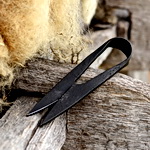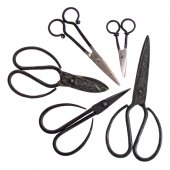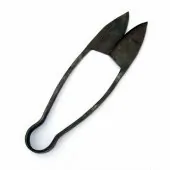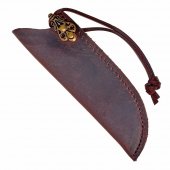Here you can buy authentic Viking spring scissors and medieval scissors replicas.
Authentic replicas of Viking ironing scissors and medieval jointed scissors.Continue ...
 The medieval scissors that you can buy here are expertly handmade and stand out for their excellent sharpness. In addition to detailed replicas of Viking spring scissors, you will also find authentic scissors from the Middle Ages that have a joint and are suitable for use as herb scissors or sewing scissors and need not hide at any medieval market. For cutting fabrics, you can find small sewing scissors as well as large fabric scissors or tailor's scissors modelled on those from the Middle Ages. You can also buy here matching leather scissor cases with which you can attach your scissors directly to your belt or, as in the Viking Age, to a ribbon on a brooch.
The medieval scissors that you can buy here are expertly handmade and stand out for their excellent sharpness. In addition to detailed replicas of Viking spring scissors, you will also find authentic scissors from the Middle Ages that have a joint and are suitable for use as herb scissors or sewing scissors and need not hide at any medieval market. For cutting fabrics, you can find small sewing scissors as well as large fabric scissors or tailor's scissors modelled on those from the Middle Ages. You can also buy here matching leather scissor cases with which you can attach your scissors directly to your belt or, as in the Viking Age, to a ribbon on a brooch. Show less
Retailers for LARP or medieval re-enactment are welcome to register for our medieval wholesale store.
Products
show 1 to 20 (out of a total of 20 articles)
Dealers for museum supplies, medieval and Viking re-enactment or LARP are cordially invited to register as retailer for wholesale in Pera Peri's medieval shop. We guarantee the best quality at good prices with short delivery times!
Scissors in Antiquity, Viking Age and Middle Ages
 At Pera Peris you can buy high quality medieval scissors!
At Pera Peris you can buy high quality medieval scissors!
 In our medieval shop you can buy a wide selection of medieval scissors, forged in detail according to historical models from the Viking Age and the early to late Middle Ages.
In our medieval shop you can buy a wide selection of medieval scissors, forged in detail according to historical models from the Viking Age and the early to late Middle Ages.The medieval scissors in our range are expertly hand-forged and of high quality workmanship and are characterized by a really excellent sharpness, so that the work is easy to do.
In addition to the typical, small Viking spring scissors, you can also buy in our Medieval Shop detailed replicas of scissors from the Middle Ages, which are equipped with a joint and were also already used in the Viking Age.
In addition to authentic ironing scissors, which were used to shorten the thread when sewing, you will also find medieval herb scissors, which were once used by monks in monastery herb gardens to cut their medicinal herbs.
For more complex sewing work, you can buy small jointed scissors, which look good in any medieval camp and will be a great help when working with needle and thread because they are sharp and easy to use.
In addition to small sewing scissors, you will also find large fabric scissors and medieval-style tailor's scissors for cutting fabrics, which you should be able to use to master any form of fabric processing.
So that the scissors are always at hand, you can also buy matching leather scissor cases in our medieval mail-order shop, with which you can carry your scissors directly on your belt.
In this way, the scissors are not only always within reach, they are also protected from rust, dirt or damage and you cannot injure yourself on the sharp edges of the scissors.
Especially in the Viking Age, small spring scissors were an indispensable part of women's garb and were often attached to a brooch with a ribbon, so that women never had to search for their scissors for a long time.
That is why you can also buy such small leather sheaths for ironing scissors from us, which we offer in various sizes. In addition to simple leather scissor cases, you will also find high-quality sheaths with bronze fittings based on historical models from the Viking Age, which are a real eye-catcher on your garb.
We are sure that you will find the right scissors for your medieval reenactment in our medieval shop.
 About the historical development of the scissors
About the historical development of the scissors
 Scissors were already widely used by the ancient Romans and the Celts of the Latène period, but in fact scissors have been known since the Bronze Age, because they were of enormous importance for the craftsmanship of fabrics and bronze sheets early on.
Scissors were already widely used by the ancient Romans and the Celts of the Latène period, but in fact scissors have been known since the Bronze Age, because they were of enormous importance for the craftsmanship of fabrics and bronze sheets early on.With the end of the Bronze Age, of course, scissors were only made of iron because the material was so much better.
The first scissors, however, simply consisted of two knife blades joined together at the end. This type of scissors is called end-jointed scissors and had to be operated with both hands at the same time.
In later times, the scissors were made from one piece and fitted with a handle, which is why these scissors are called spring scissors.
The handle gives the scissors the necessary tension so that the scissors can be used with only one hand.
 Scissors in medieval and Viking times
Scissors in medieval and Viking times
 Spring scissors existed from antiquity through the Viking Age and the Middle Ages to modern times, and they were used in many different sizes and shapes.
Spring scissors existed from antiquity through the Viking Age and the Middle Ages to modern times, and they were used in many different sizes and shapes.There were tiny sewing scissors with which one could only cut a thread, scissors for hair care, handy sheep or cloth scissors, even monstrously large cloth scissors that could be up to a metre long - all these scissors were ironing scissors without any joint, only connected with an elastic bow.
The spring scissors have been in use for over 2000 years and their form has remained completely unchanged to this day. Of course, you can buy exactly such ironing scissors in our medieval online shop.
By the way: Contrary to the widespread prejudice, the Vikings attached great importance to a well-groomed appearance. Therefore, the scissors were an integral part of the costume of the women of the Viking Age and hung together with awl, ear spoon and tweezers from a brooch attached to the shoulders.
But even in the late Middle Ages, the scissors were seen as a female attribute and were often used symbolically in this context.
The joint scissors that are so widespread here today came into the light of day quite late and were actually in use only very sporadically before the 10th century. Nevertheless, jointed scissors can already be found in Viking archaeological finds, such as those from Birka and Novgorod.
In contrast to the ironing scissors, the jointed shears have two blades mounted around a pivot point, which makes it easier and more precise to work with. Also, in contrast to the ironing scissors, the articulated shears can be closed over the entire length of their cutting edge and do not stand open.
Maybe you enjoyed this little excursion about medieval scissors and you will find a suitable pair of scissors in our medieval mail order shop that you would like to buy to complement your authentic equipment.

